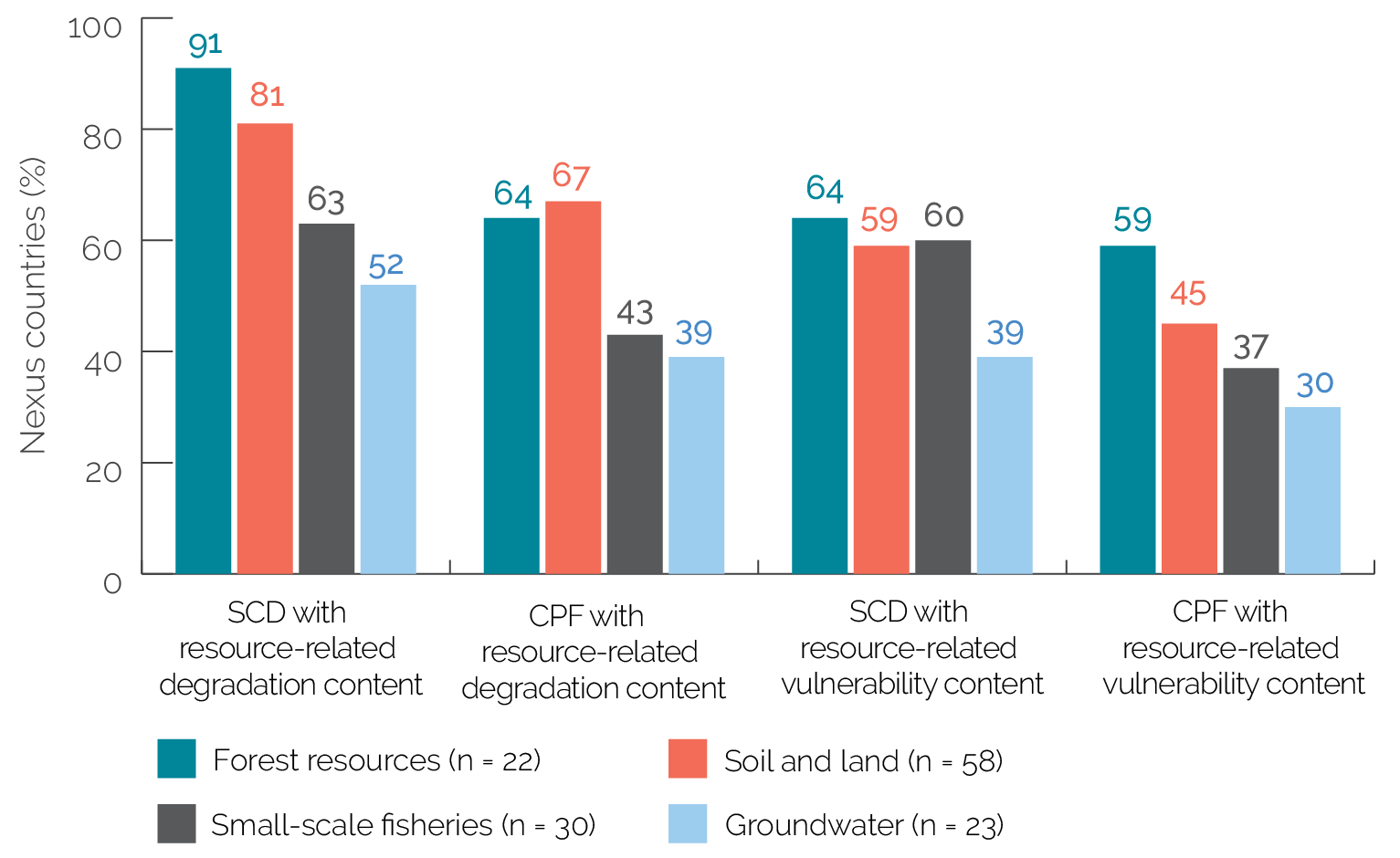The Natural Resource Degradation and Vulnerability Nexus:
Chapter 2 | Doing the Right Things in the Right Places to Address Natural Resource Degradation and Human Vulnerability
Highlights
The World Bank adequately diagnoses and addresses forest and soil and land degradation issues but not groundwater and small-scale fishery issues.
However, there is a dearth of analysis in many Systematic Country Diagnostics (SCDs) about the way that resource degradation is threatening the welfare and livelihoods of poor, resource-dependent people in the places where these threats are most prominent. There is a tendency for SCDs and Country Partnership Frameworks not to refer to both resource degradation and associated vulnerability, although this occurs more frequently when forest resource issues are diagnosed.
SCDs, Country Partnership Frameworks, and lending programs for sustainable land management, forest resources, and groundwater do not address many of the complex factors that drive resource degradation. SCDs and Country Partnership Frameworks for small-scale fishery nexus countries, however, directly address the underlying drivers of depletion, such as policy, regulatory, and institutional drivers.
This chapter examines the extent to which the World Bank identifies and addresses resource degradation issues threatening resource-dependent people in the places where those threats are most prominent. Specifically, it examines whether and how often the World Bank diagnoses resource degradation and associated human vulnerability issues in its Systematic Country Diagnostics (SCDs) and whether it addresses these issues in its Country Partnership Frameworks (CPFs) and country lending programs. This analysis is conducted for countries with relatively high resource degradation and high resource dependence among poor resource users. Such countries are referred to as “nexus countries” (table 2.1; see expanded methodology in appendix A). Of the 101 nexus countries, this chapter assesses the 87 with SCDs, CPFs, and active country lending portfolios (that is, countries that are not in arrears). This chapter first examines the inclusion of resource degradation and associated human vulnerability in SCDs, CPFs, and lending across all natural resources for all nexus countries. It then focuses on issues specific to each of the natural resources that are the subject of this evaluation: soil and land, local forest resources, groundwater, and small-scale fisheries. Advisory services and analytics (ASA) were not assessed because these were considered as critical inputs into—and therefore reflected in—the SCDs and CPFs where they existed.
Table 2.1. Identification of Natural Resource Degradation and Vulnerability Nexus Countries
|
Resource |
Resource Degradation Indicators |
Resource Dependence Indicators |
Nexus Countries |
|
Soil and land
 |
|
|
n = 58
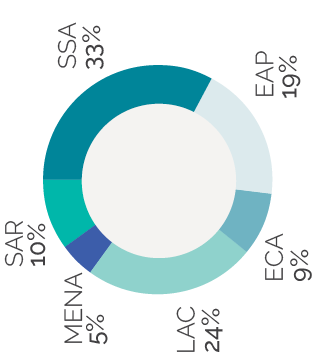 |
|
Local forest resources
 |
|
|
n = 22
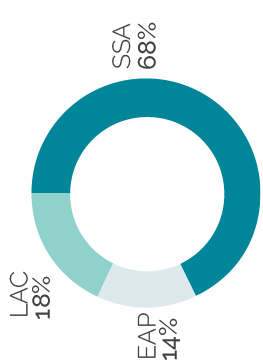 |
|
Groundwater
 |
|
|
n = 23
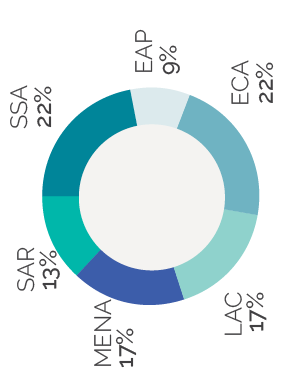 |
|
Small-scale fisheries
 |
|
|
n = 30
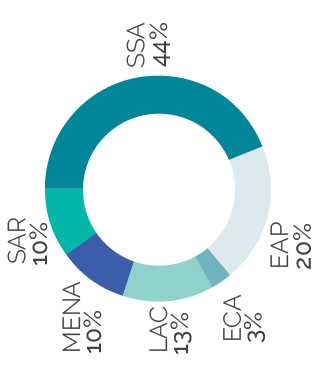 |
Source: Independent Evaluation Group
Note: EAP = East Asia and Pacific; ECA = Europe and Central Asia; FAOSTAT = Food and Agriculture Organization Statistics Division; ILO = International Labour Organization; LAC = Latin America and the Caribbean; Mg/ha/year = megagrams per hectare per year; MENA = Middle East and North Africa; SAR = South Asia; SEforALL = Sustainable Energy for All; SSA = Sub-Saharan Africa; WDI = World Development Indicators.a. Aqueduct 3.0 (database), World Resources Institute, https://www.wri.org/aqueduct.
Overall Analysis
The SCDs of forest and soil and land nexus countries often diagnose these resource degradation issues, whereas the SCDs of groundwater and small-scale fisheries nexus countries often do not. Most SCDs of forest and soil and land nexus countries (91 and 81 percent, respectively) include a description of, and sometimes data on, forest and soil and land degradation issues (figure 2.1). However, SCDs of small-scale fisheries and groundwater nexus countries only diagnose these resource degradation issues in, respectively, 63 and 52 percent of the nexus countries.
CPFs adequately cover forest and soil and land degradation but not groundwater and small-scale fisheries issues. Across all nexus countries, there is a drop in resource-related coverage from SCDs to CPFs: 20–27 percent for small-scale fisheries and forest issues and 13–14 percent for groundwater and soil and land (figure 2.1). Although there is substantial coverage of forest and soil and land degradation issues in nexus countries—considering competing priorities—coverage is low for small-scale fisheries and groundwater issues.
Figure 2.1. Natural Resource Degradation Issues in SCDs, CPFs, and Lending in Nexus Countries

Source: Independent Evaluation Group.
Note: CPF = Country Partnership Framework; SCD = Systematic Country Diagnostic.
CPFs that do not carry resource degradation issues through from the SCD display one of four characteristics. Twenty-five CPFs did not refer to resource degradation even though the corresponding SCDs did. Four factors explain these gaps:
- A CPF’s focus on corporate climate change mitigation goals may crowd out references to resource degradation and human vulnerability. This occurs predominantly in Latin America and the Caribbean, even in countries with relatively low greenhouse gas emission targets (for example, El Salvador and Guatemala).
- CPFs that focus on disaster risk management may drop references to resource degradation exacerbating vulnerability (as in the Comoros, Mauritius, and the Philippines). These omissions need not occur—the CPF in Honduras addresses disaster risks intensified through forest and soil degradation by applying an integrated agriculture and water management approach.
- Several International Bank for Reconstruction and Development (IBRD)/Blend small-scale fisheries nexus countries with adequate diagnostics (for example, China, the Republic of Congo, the Dominican Republic, and Nigeria) omit the issue in the CPF and have no small-scale fisheries lending.
- Some Central American IBRD nexus countries (for example, El Salvador and Guatemala) are not borrowing for natural resource management because support for other topics (for example, urban governance) is being prioritized, in a context in which projects have been limited in the analyzed years.
SCDs and CPFs refer less to resource-related human vulnerability than to resource-related degradation. Roughly 40–60 percent of SCDs and 30–60 percent of CPFs refer to resource-related vulnerability, with more complete coverage for forest-related vulnerability than for other resources (figure 2.2). Although vulnerability is highly contextual, SCDs that examine resource-related human vulnerability refer—at a minimum—to vulnerable groups (for example, poor farmers, vulnerable herders, women). Half cite the locations of vulnerable resource users but only when there is lending. Even so, this analysis is partial: migrants, the landless, historically disadvantaged peoples, unmarried women, and other marginalized resource users are not mentioned. Few SCDs and CPFs provide data on resource-related livelihoods (for example, welfare, income, or jobs). Almost none analyze the social constraints that exacerbate vulnerability (for example, the ability to participate in resource-related decision-making, the rights to use or benefit from resources). In small-scale fisheries nexus countries, SCDs point to livelihood risks associated with depletion but not to marginalization or resource competition with large fishing vessels.
Figure 2.2. Coverage of Resource-Related Vulnerability versus Resource-Related Degradation in SCDs and CPFs in Nexus Countries
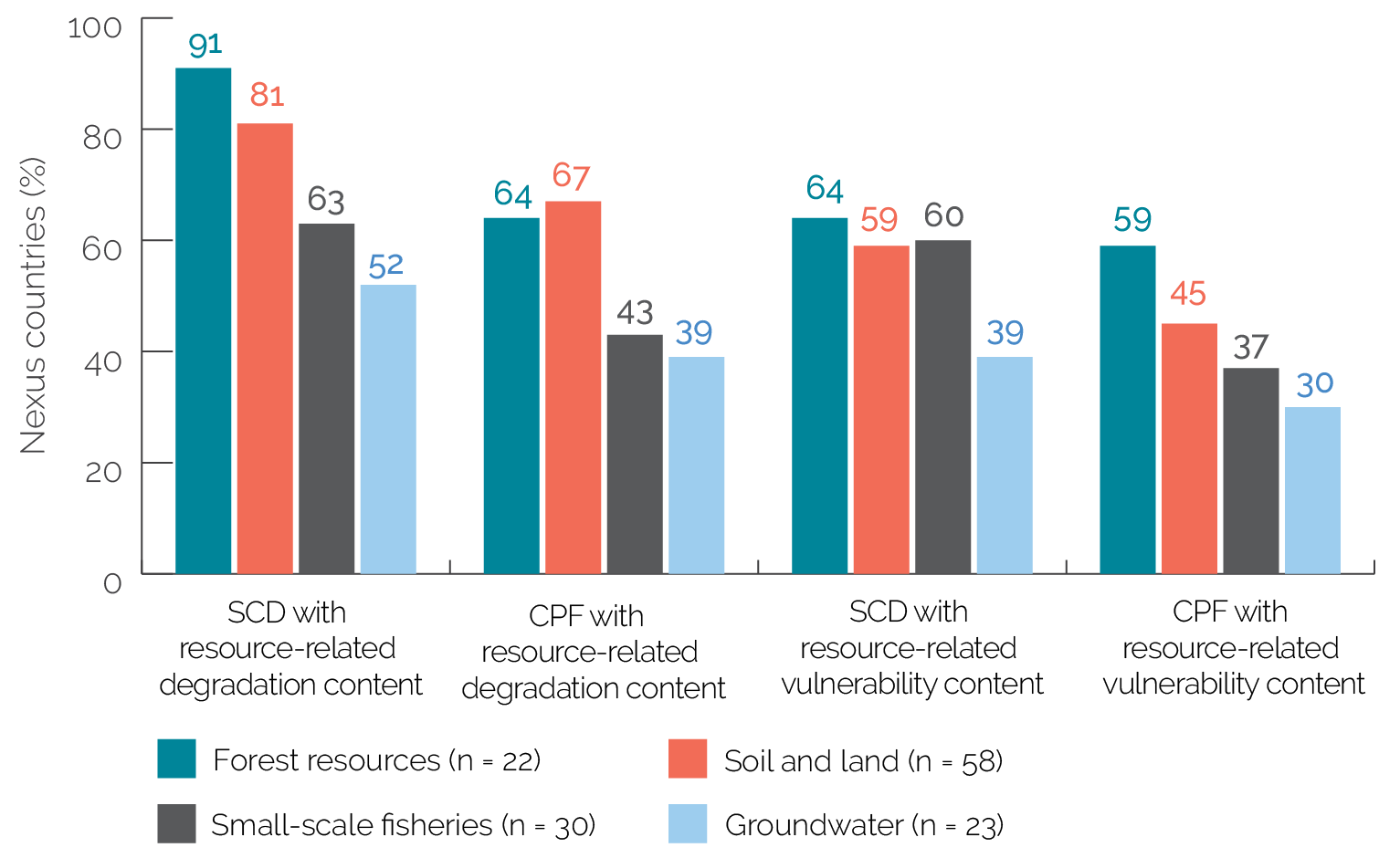
Source: Independent Evaluation Group.
Note: CPF = Country Partnership Framework; SCD = Systematic Country Diagnostic.
Gender-related resource management and use rights are not diagnosed in SCDs and thus not addressed in country strategies and lending programs. Nexus country SCDs make few references to gender-related natural resource access and use rights, and the corresponding CPFs make almost no commitments to address these issues. This is important because women (and many marginalized groups) tend to have low participation in traditional natural resource governance structures.1 It is also important because resource access rights might differ from resource use rights.2
Degradation-induced and resource-related conflicts that increase the vulnerability of resource users are often cited in the SCDs of nexus countries but not in the associated CPFs. Half of the SCDs (45 of 89) point to either the presence or the risk of resource-related conflict. However, 70 percent of the associated CPFs do not refer to these risks. There is more depth and consistency in the treatment of resource-related conflict risks in the SCDs for countries affected by fragility, conflict, and violence, especially in the Sahel. Sahelian SCDs refer to conflict risks associated with competition for arable and grazing land due to degradation and water scarcity, exacerbated by drought and demographic growth. They almost always point to mortal conflicts between farmers and pastoralists. However, references to these risks are frequently dropped in South Asia (except for Afghanistan) and in the Middle East and North Africa Region. Notably, references to agropastoral conflict are also dropped in the Côte d’Ivoire, Mali, Nigeria, and South Sudan CPFs. Nevertheless, there has been increased integration of resource-related conflict risk mechanisms in design (see chapter 3).
Overall, SCDs and CPFs in nexus countries tend not to jointly analyze resource degradation and human vulnerability. References to both natural resource degradation and associated human vulnerability jointly occurred most frequently in forest resource nexus countries (in 64 and 55 percent of SCDs and CPFs, respectively) and least frequently in groundwater nexus countries (39 and 30 percent; figure 2.3). But there is a dearth of analysis across many nexus countries about the way that resource degradation threatens the welfare and livelihoods of poor, resource-dependent persons in the places where these threats are most prominent.
Figure 2.3. Natural Resource Degradation and Vulnerability in SCDs and CPFs in Nexus Countries
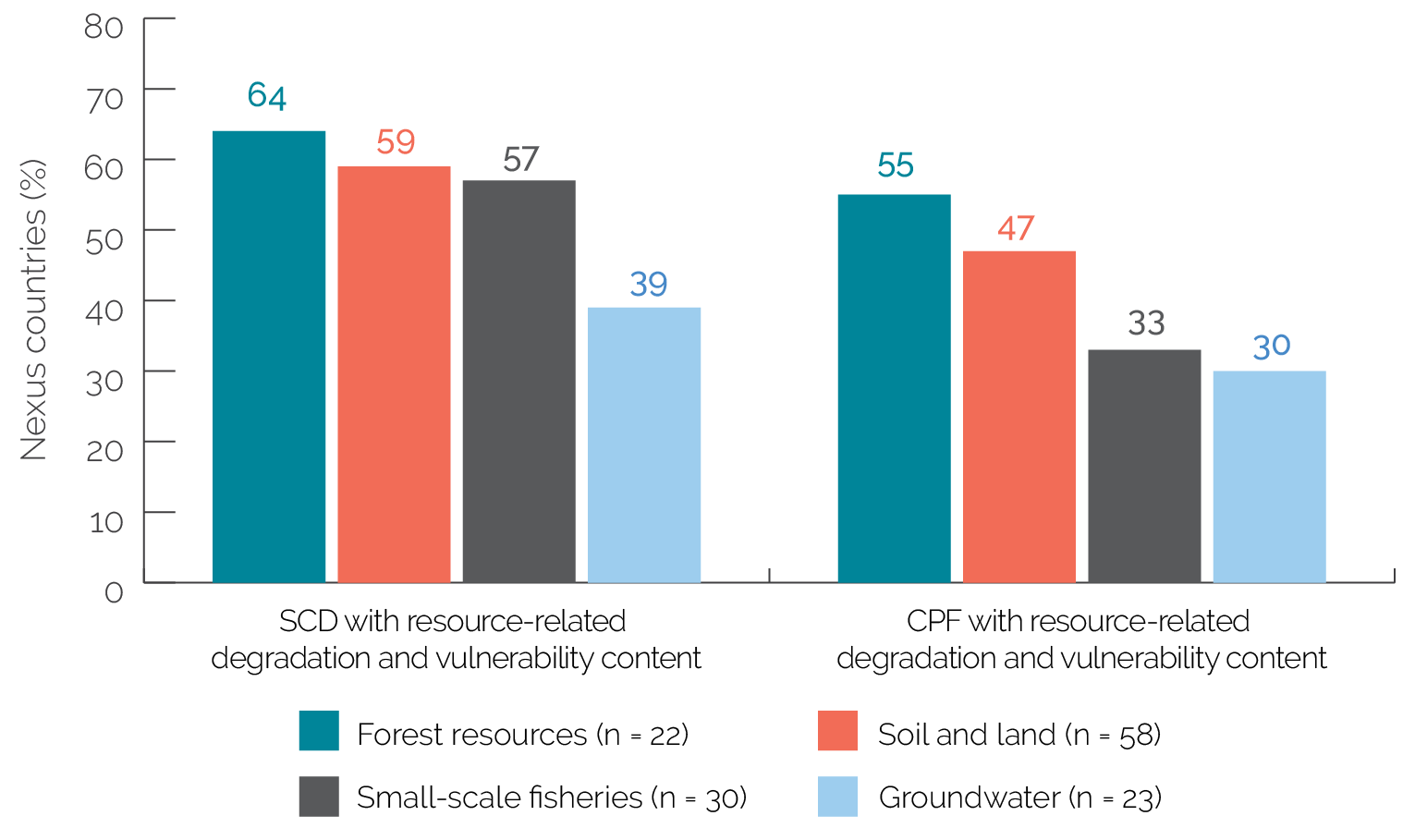
Source: Independent Evaluation Group.
Note: CPF = Country Partnership Framework; SCD = Systematic Country Diagnostic.
Soil and Land Resources
The World Bank diagnoses and addresses soil and land degardation issues in at least two-thirds of soil and land nexus countries. SCDs diagnose and country lending addresses soil and land degradation in 81 and 69 percent of soil and land nexus countries, respectively (figure 2.1). There are several examples where soil and land degradation and associated human vulnerability are well diagnosed and addressed in the SCD, CPF, and country lending program (identified in green in map 2.1). They include countries such as Cameroon, whose SCD analyzes the “soil fertility–poverty trap,” and Honduras, whose SCD links soil degradation to deforestation and whose CPF supports resource-dependent populations in the Corredor Seco, where 92 percent of the population lives below the extreme poverty line.
Although the World Bank often diagnoses and addresses soil and land degradation issues, CPFs and lending lack a resource-related vulnerability focus. In some Central and South American countries, the lack of a vulnerability focus in the lending portfolio is due to the terms of the blended concessional finance (IBRD, carbon finance, and the Global Environment Facility), which targets large and medium-size farms (see discussion of the Cerrado in the Discounted Loans section in chapter 4). In East Asia, including in China and Mongolia, vulnerability-related aims were included in closed NRDV projects but not in similar active ones, even though the SCDs continue to cite the vulnerability of resource user groups who are physically or socially isolated, aged, or disabled. For example, in Mongolia, the first two phases of the Sustainable Livelihood Project (2002–07, 2007–13) focused on herder vulnerability, but the most recent phase dropped this support.
Although the World Bank addresses soil and land degradation frequently and in most of the right places, it inadequately addresses its drivers. SCDs acknowledge the issue of soil and land degradation, but many of them limit their diagnostics to poor farming or grazing practices, exacerbated by climatic conditions. Few SCDs point to policy distortions, including perverse incentives or lack of clearly defined property rights, or to the economic, regulatory, and resource governance factors and negative externalities that lead to market failures and drive degradation. Neither do many SCDs situate land and soil degradation within a wider context, for example, by considering the rapid growth of commodities or urbanization and migration trends.
Map 2.1. Coherence among SCDs, CPFs, and Lending for Soil and Land Degradation in Nexus Countries
World Bank lending infrequently addresses the role of tenure insecurity and resource use rights in providing incentives for sustainable land management (SLM). Although almost 80 percent of the 58 SCDs for soil and land nexus countries cite a lack of secure land tenure or use rights as a constraint on SLM, only eight World Bank investments in seven countries address tenure insecurity. This issue is especially pertinent in Africa, where conflicting land rights undermine incentives for land-based investments and where all but one of the 24 SCDs cite land tenure insecurity as a challenge (see also Deininger, Savastano, and Xia 2017; Holden and Otsuka 2014). Good examples of relevant World Bank assistance in this area include support for local land titling, communal rights, or land certificates in Burkina Faso, Ethiopia, Ghana, Madagascar, Malawi, and Uganda.
A lack of focus on tenure insecurity and use rights undermined long-term vulnerability reduction in the Sahel. The World Bank catalyzed more than $1 billion of finance from the International Development Association and other sources (for example, the Global Environment Facility) to address land degradation and human vulnerability in the Sahel. Land degradation and associated vulnerability issues were well captured in the SCDs and CPFs and were addressed through the Sahel and West Africa Program. The projects were highly participatory and designed to (i) use various dryland technologies to help restore degraded land and (ii) reduce short-term vulnerability by delivering local investments (health, education, infrastructure) and cash-for-work arrangements in exchange for land restoration efforts. However, inadequate attention to land and resource use rights undermined the potential for longer-term vulnerability reduction (see also chapter 4).
Forest Resources
The World Bank coherently addresses forest resource loss in places where the local poor people most depend on these resources for their livelihoods and well-being. Of the SCDs in forest nexus countries, 91 percent include references to forest degradation issues, and 77 percent of these nexus countries include lending to address the issues raised in the associated SCDs (figure 2.1). This is especially the case in eastern and southern Africa (except for South Africa), where ASA, technical assistance, and investments have been designed to address the drivers of forest resource degradation while enhancing forest resource users’ well-being in areas of high poverty (map 2.2). Energy-related risks are addressed through efforts to promote fuel switching and sustainable charcoal production in Madagascar and Zambia. However, in West Africa, World Bank engagement in Guinea, Sierra Leone, and Togo does not include investments that directly address forest degradation, biomass dependence, and forest-related livelihoods, even though these SCDs cite significant forest-related vulnerability.3
SCDs for forest nexus countries associate vulnerability with biomass dependence, a risk that is often not addressed through lending. Vulnerability in forest nexus countries is associated with biomass dependence for cooking and heating. In most African countries, the energy sector is dominated by traditional biomass-based energy sources (for example, fuelwood). The issue of biomass dependence is also significant for vulnerable families in Latin America and the Caribbean who engage in indoor cooking. Biomass dependence is diagnosed in 80 percent of the SCDs of forest nexus countries but addressed though lending only in Benin, Madagascar, Mozambique, and Uganda.
Although SCDs include information on forest-dependent communities, they rarely analyze forest-related livelihoods, including monetary and nonmonetary benefits. Subnational livelihood data—collected from surveys and case studies—were provided in four SCDs: Argentina, Cambodia, Indonesia, and Madagascar. These data were also reflected in the targeting strategies of relevant poverty-focused forest projects.
Map 2.2. Coherence among SCDs, CPFs, and Lending for Forest Resources in Landscapes in Nexus Countries
Groundwater Resources
Groundwater depletion issues are both underdiagnosed in SCDs and CPFs and insufficiently addressed through lending in nexus countries. Groundwater depletion is addressed in 52 percent of the SCDs of groundwater nexus countries and 39 percent of the associated CPFs, and much of the relevant lending in these nexus countries is closed and shrinking (figure 2.1). There is strong alignment—across diagnostics, strategy, and programming (ASA and lending)—on addressing groundwater issues in Botswana, India, Iraq, and Mexico (map 2.3).4 But although there was strong alignment between diagnostics and lending in the Middle East and North Africa early in the evaluation period, investment support has not continued.
Country programs address the physical drivers of groundwater degradation but not the political economy drivers. Most nexus country SCDs associate groundwater depletion with inefficient or outdated irrigation, water-intensive cropping, and water-intensive industries. Half of the SCDs refer to political economy challenges (for example, water and energy price distortions, weak enforcement, lack of cost recovery) and only three (the Arab Republic of Egypt, India, and Mexico) point to distortionary effects of subsidized irrigation water use, which can lead to overexploitation, leakage, and suboptimal cropping decisions.
Wider patterns of groundwater degradation related to human vulnerability require more contextual analysis. In the context of groundwater depletion, SCDs focus on the inefficiency of irrigation systems. These SCDs often neither include groundwater data nor cite vulnerable populations. But there is a demand for more knowledge about groundwater depletion and its effects on health and welfare. For example, the Mexico SCD points to the need for more groundwater research since groundwater accounts for 65 percent of water used by Mexican cities.
Map 2.3. Coherence among SCDs, CPFs, and Lending for Groundwater Depletion in Nexus Countries
Small-Scale Fisheries Resources
Although many SCDs in nexus countries include analysis of small-scale fisheries depletion, these issues are often not addressed in the CPFs and lending programs. Sixty-three percent of SCDs analyze small-scale fisheries depletion, but this issue is addressed in only 43 percent of nexus CPFs and in 40 percent of lending (figure 2.1). The World Bank provided relevant support to fishing communities within nexus countries along the western African coast and in the southwest Indian Ocean. In these regions, the SCDs focused on the vulnerability-inducing effects of fish depletion (due to overfishing and unregulated fishing), and the CPFs included regional lending and technical assistance programs that address policy, regulatory, and institutional drivers of small-scale fisheries depletion (map 2.4). However, the World Bank does not adequately address these issues in coastal central Africa, where overfishing is increasing vulnerability.5 In this region, several SCDs reference this, but CPFs do not address it.
The diagnosis of vulnerability is often incomplete in SCDs for small-scale fisheries nexus countries. Although SCDs for small-scale fisheries nexus countries point to livelihood and food insecurity risks from overexploitation, they do not analyze the increasing marginalization and competition facing fishing communities. These issues are also not reflected in lending. The focus on overexploitation in the SCDs results in projects designed to improve fisheries management and conservation. This also results in projects that are not designed with a vulnerability lens: small-scale fisheries projects often do not include mechanisms to compensate or provide safety nets to fishers. Meanwhile, these fishers face structural threats from the consolidation of the fishing industry, which affects customary resource allocation practices, and from conflict with large-scale fishing operations. Integrating vulnerability considerations into the SCDs could help inform the design of small-scale fisheries projects that address the challenges of common-pool resources.
Map 2.4. Coherence among SCDs, CPFs, and Lending for Small-Scale Fisheries in Nexus Countries
- There is long-standing literature on women’s comparative exclusion from traditional natural resource governance structures (UN Women 2013). Although poor rural women are often highly dependent on natural resources, they are largely excluded from traditional decision-making processes (Hyle, Devkota, and Mustalahti 2019). This is even the case when such institutions seem participatory (Agarwal 2001). Often, women have only usufruct rights to land, where their access is mediated through their male relations and their rights are an extension of their family support role rather than their individual rights (Kusakabe, Shrestha, and Veena 2015).
- For example, women or other marginalized groups might hold access rights to land (that is, permission to enter the land) without being allowed to withdraw resources from it (that is, withdrawal rights; RRI 2014). Alternatively, women might have access and withdrawal rights but no management rights; they cannot regulate or make decisions over the resources they use (RRI 2014).
- The western Guinean lowland forests provide up to 35 percent of all goods and noncash income to households (Darwall et al. 2015).
- In Botswana, for example, where groundwater accounts for half of all water used and where these resources are at or near their capacity for sustainable use, the World Bank is helping enhance watershed and aquifer management, including in drought-prone areas. In Iraq, the focus in the diagnostics and the lending program is on preparedness: investments in water supply and sanitation include groundwater management of the country’s water security planning activities because of the lack of alternative water resources to the Tigris. The World Bank’s diagnostics have emphasized the need to study groundwater and introduce water savings, water consumption reduction, and water loss reduction to ensure continued water access for 5 million Baghdad residents (over 80 percent of the Baghdad population). In Mexico, millions of citizens are facing water scarcity because the number of overexploited aquifers tripled between 1975 and 2013. Overpumping is causing land subsidence, which makes flooding worse and causes structural damage to urban infrastructure. To respond to these threats, the World Bank is implementing a large-scale effort to strengthen the management of groundwater resources in the Valley of Mexico and help improve the efficiency of the water transfer plans under the Cutzamala System—the second-largest source of water for Mexico City and the State of Mexico (World Bank 2020c).
- In this region, fish provide a major source of animal protein for coastal communities, which account for approximately 40 percent of the population (Polidoro et al. 2016). But many bony fish species are in danger of global extinction due to overfishing, degradation of habitats, pollution, and climate change.



